
The Ban Liang was the first unified currency of the Chinese empire, first minted as early as 378 BCE and introduced by the first emperor Qin Shi Huang as China's first unified currency around 210 BC. It was round with a square hole in the middle. Before that date, a variety of coins were used in China, usually in the form of blades or other implements, though round coins with square holes were used by the State of Zhou before it was extinguished by Qin in 249 BCE.

Knife money is the name of large, cast, bronze, knife-shaped commodity money produced by various governments and kingdoms in what is now China, approximately 2500 years ago. Knife money circulated in China between 600 and 200 B.C. during the Zhou dynasty.

Ancient Chinese coinage includes some of the earliest known coins. These coins, used as early as the Spring and Autumn period (770–476 BCE), took the form of imitations of the cowrie shells that were used in ceremonial exchanges. The same period also saw the introduction of the first metal coins; however, they were not initially round, instead being either knife shaped or spade shaped. Round metal coins with a round, and then later square hole in the center were first introduced around 350 BCE. The beginning of the Qin dynasty (221–206 BCE), the first dynasty to unify China, saw the introduction of a standardised coinage for the whole Empire. Subsequent dynasties produced variations on these round coins throughout the imperial period. At first the distribution of the coinage was limited to use around the capital city district, but by the beginning of the Han dynasty, coins were widely used for such things as paying taxes, salaries and fines.

The cash or qian was a type of coin of China and the Sinosphere, used from the 4th century BC until the 20th century AD, characterised by their round outer shape and a square center hole. Originally cast during the Warring States period, these coins continued to be used for the entirety of Imperial China. The last Chinese cash coins were cast in the first year of the Republic of China. Generally most cash coins were made from copper or bronze alloys, with iron, lead, and zinc coins occasionally used less often throughout Chinese history. Rare silver and gold cash coins were also produced. During most of their production, cash coins were cast, but during the late Qing dynasty, machine-struck cash coins began to be made. As the cash coins produced over Chinese history were similar, thousand year old cash coins produced during the Northern Song dynasty continued to circulate as valid currency well into the early twentieth century.
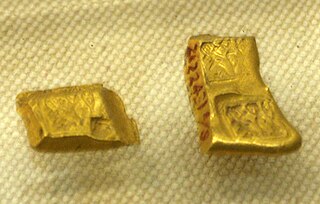
Ying Yuan were stamped blocks of gold bullion. This was an early form of currency that could be considered a precursor to gold coins. They were issued by the ancient Chinese state of Chu during the Warring States period between the 400s and late 200s BCE.

Yansheng Coins, commonly known as Chinese numismatic charms, refer to a collection of special decorative coins that are mainly used for rituals such as fortune telling, Chinese superstitions, and Feng shui. They originated during the Western Han dynasty as a variant of the contemporary Ban Liang and Wu Zhu cash coins. Over the centuries they evolved into their own commodity, with many different shapes and sizes. Their use was revitalized during the Republic of China era. Normally, these coins are privately funded and cast by a rich family for their own ceremonies, although a few types of coins have been cast by various governments or religious orders over the centuries. Chinese numismatic charms typically contain hidden symbolism and visual puns. Unlike cash coins which usually only contain two or four Hanzi characters on one side, Chinese numismatic charms often contain more characters and sometimes pictures on the same side.
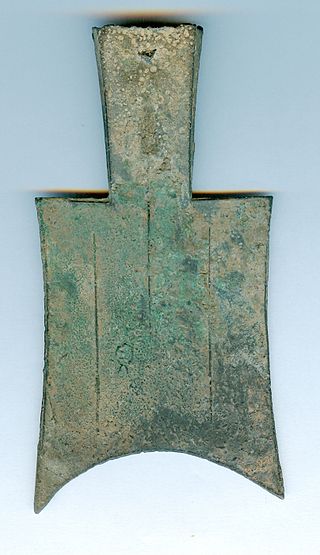
Spade money was an early form of coin and commodity money used during the Zhou dynasty of China. Spade money was shaped like a spade or weeding tool, but the thin blade and small sizes of spade money indicate that it had no utilitarian function. The earlier versions of spade coins tended to have a fragile, hollow socket, reminiscent of a metal shovel. Later versions of spade money had this socket transformed into a thin, flat piece, and over time, inscriptions were added to the spade coins to mark their denominations. Several versions of spade money circulated across the Chinese Central Plains during the Zhou dynasty period until they were abolished by the Qin dynasty in 221 BC in favour of the Ban Liang cash coins.

The Jin dynasty was a Jurchen-led dynasty of China that ruled over northern China and Manchuria from 1115 until 1234. After the Jurchens defeated the Liao dynasty and the Northern Song dynasty, they would continue to use their coins for day to day usage in the conquered territories. In 1234, they were conquered by the Mongol Empire.

Xin dynasty coinage was a system of Ancient Chinese coinage that replaced the Wu Zhu cash coins of the Han dynasty and was largely based on the different types of currencies of the Zhou dynasty, including Knife money and Spade money. During his brief reign, Wang Mang introduced a total of four major currency reforms which resulted in 37 different kinds of money consisting of different substances, different patterns, and different denominations.

The Kaiyuan Tongbao, sometimes romanised as Kai Yuan Tong Bao or using the archaic Wade-Giles spelling K'ai Yuan T'ung Pao, was a Tang dynasty cash coin that was produced from 621 under the reign of Emperor Gaozu and remained in production for most of the Tang dynasty until 907. The Kaiyuan Tongbao was notably the first cash coin to use the inscription tōng bǎo (通寶) and an era title as opposed to have an inscription based on the weight of the coin as was the case with Ban Liang, Wu Zhu and many other earlier types of Chinese cash coins. The Kaiyuan Tongbao's calligraphy and inscription inspired subsequent Central Asian, Japanese, Korean, Ryūkyūan, and Vietnamese cash coins and became the standard until the last cash coin to use the inscription "通寶" was cast until the early 1940s in French Indochina.
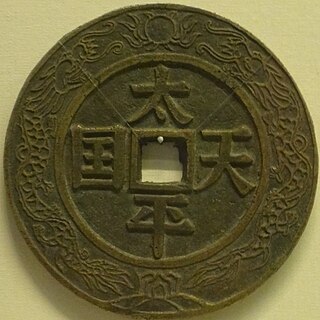
The currency of the Taiping Heavenly Kingdom consisted of Chinese cash coins and paper money, although the rarity of surviving Taiping paper money suggests that not much was produced. The first cash coins of the Taiping Heavenly Kingdom were issued in the year 1853 in the capital of Tianjing. The cash coins of the Taiping Heavenly Kingdom should not be confused with the Taiping Tongbao (太平通寳) which was issued during the Northern Song dynasty between the years 976 and 997, or with any other contemporary rebel coinage that also bear this inscription.

The coinage of the Southern Tang dynasty consisted mostly of bronze cash coins while the coinages of previous dynasties still circulated in the Southern Tang most of the cash coins issued during this period were cast in relation to these being valued as a multiple of them.

The Great Qing Copper Coin, also known as the Qing Dynasty Copper Coin or Da-Qing Tongbi, officially the Tai-Ching-Ti-Kuo Copper Coin, refers to a series of copper machine-struck coins from the Qing dynasty produced from 1906 until the fall of the Qing dynasty in 1911. These coins were intended to replace the earlier cast cash coins and provincial coinages, but were welcomed to mixed receptions.
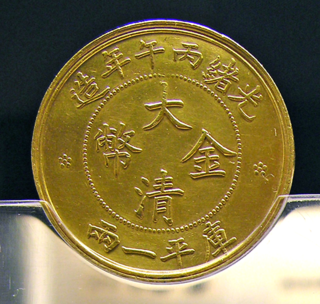
The Great Qing Gold Coin, also known as the Qing Dynasty Gold Coin or Da-Qing Jinbi, was the name of an unissued series of gold coins produced under the reign of the Guangxu Emperor of the Manchu-led Qing dynasty. These coins were produced in the scenario that the government of the Qing dynasty would adopt the gold standard, as was common in most of the world at the time.
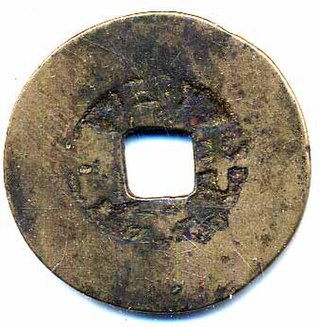
Bingqian, or Bingxingqian, is a term, which translates into English as "biscuit coins", "pie coins", or "cake coins", used by mainland Chinese and Taiwanese coin collectors to refer to cash coins with an extremely broad rim as, these cash coins can also be very thick. While the earliest versions of the Bingqian did not extraordinarily broad rims.

Buddhist coin charms are a category of Chinese, Japanese, Korean, and Vietnamese numismatic charms that depict Buddhist religious imagery or inscriptions. These coin charms often imitate the design of Chinese cash coins, but can exist in many different shapes and sizes. In these countries similar numismatic charms existed for Confucianism and Taoism, and at times Buddhist coin charms would also incorporate symbolism from these other religions.
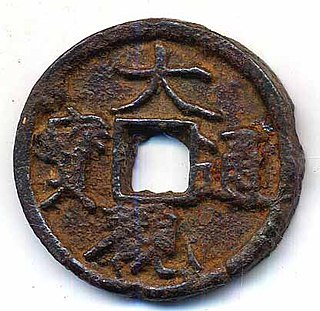
Iron cash coins are a type of Chinese cash coin that were produced at various times during the monetary history of imperial China as well as in Japan and Vietnam. Iron cash coins were often produced in regions where the supply of copper was insufficient, or as a method of paying for high military expenditures at times of war, as well as for exports at times of trade deficits.

Chinese burial money a.k.a. dark coins are Chinese imitations of currency that are placed in the grave of a person that is to be buried. The practice dates to the Shang dynasty when cowrie shells were used, in the belief that the money would be used in the afterlife as a bribe to Yan Wang for a more favourable spiritual destination. The practice changed to replica currency to deter grave robbers, and these coins and other imitation currencies were referred to as clay money (泥錢) or earthenware money (陶土幣).























